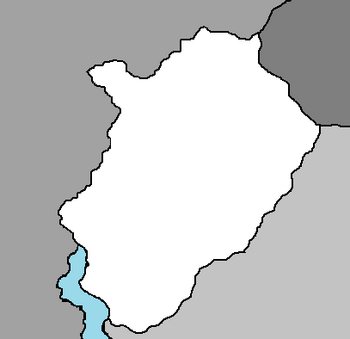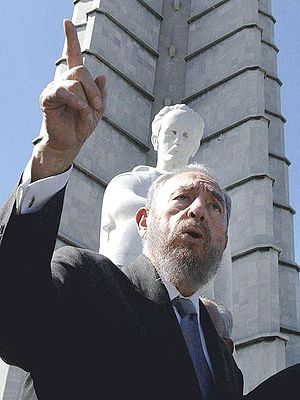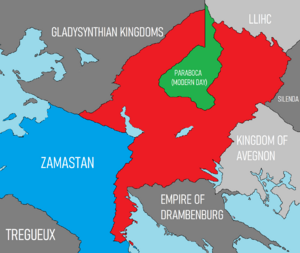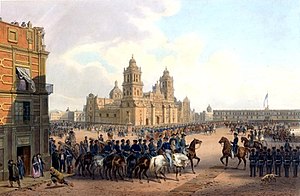West Chanchajilla
Republic of Chanchajilla | |
|---|---|
|
Flag | |
 | |
| Capital | Ivora |
| Recognised national languages | English, French |
| Government | Parliamentary constitutional republic |
| Juan Diego Barrios | |
| Aimar Bacque | |
| Establishment | |
• Unification of Chanchajilla | 1450 |
• Chanchajilla breaks apart | 1932 |
• People's Republic of Chanchajilla | 1951 |
• Republic of West Chanchajilla | 2021 |
| Population | |
• 2020 estimate | 16,300,000 |
| GDP (PPP) | 2020 estimate |
• Total | 74.96 billion |
| Currency | Chancu Dimo |
| Date format | mm-dd-yyyy |
West Chanchajilla, known also as the Republic of West Chanchajilla as of 2021 and formerly the People's Republic of Chanchajilla is a nation located on the continent of Euronia in the Coalition of Crown Albatross. It is bordered by Gladysynthia, Paraboca, and East Chanchajilla. The west and east had been unified as Greater Chanchajilla from their respective kingdoms since 1450, although a brutal occupation and resulting violent Parabocan War eventually eroded the social and governmental states of the nation. The separation of Chanchajilla and the ensuing Chanchajillan Civil War in 1932-44 resulted in two separate nations; east and west. West Chanchajilla established a military regime adopted many socialist economic policies, which cut it off from much of the world, while East Chanchajilla, which remained a capitalist-centered economy with more political freedoms than their neighbors to the west, gained significant aid from Zamastan, who provided packages that built their military, infrastructure, and economics.
Oil was discovered in the early 20th century. Previously, the country was an underdeveloped exporter of agricultural commodities such as coffee and cocoa, but oil quickly came to dominate exports and government revenues. The 1980s oil glut led to an external debt crisis and a long-running economic crisis. Inflation peaked at 100% in 1996 and poverty rates rose to 66% in the late 90's. The Treviso Nuclear Crisis in 1992 is considered to be the worst man-made disaster in history, and led to heavy international restrictions on West Chanchajilla. The regime under Parish White established populist social welfare policies that initially boosted the nation's economy and increased social spending, temporarily reducing economic inequality and poverty in the early years of the regime.
In 2005, Parish White died, and was succeeded by his protege, Frederick Armbar. Armbar continued the populist policies of White, but with disastrous results. The nation's economy collapsed because of their excesses—including a uniquely extreme fossil fuel subsidy—and are widely blamed for destabilizing the nation's economy. The destabilized economy led to a crisis in West Chanchajilla, resulting in hyperinflation, an economic depression, shortages of basic goods and drastic increases in unemployment, poverty, disease, child mortality, malnutrition and crime. These factors have precipitated the West Chanchajillan migrant crisis where more than two million people have fled the country, mostly to neighboring East Chanchajilla and Zamastan. East and West have also had multiple violent and sporadic conflicts between on their border in the past century, including the South Turania Offensive. In late February 2020, thousands of protesters attempted to overthrow the Armbar dictatorship, but were crushed by government forces. In 2021, Armbar launched violent attacks against East Chanchajilla, culminating in the 2021 Chanchajilla War. Armbar was killed during the conflict, and it marked the end of socialist dictatorship in the country as national elections were held in August of 2021, with a new Constitution being adopted and Juan Diego Barrios being elected Prime Minister.
History
Early Age
Unification of Kingdoms
Parabocan Occupation
Throughout the late 1700's and early 1800's, the military dictatorships of Paraboca thrived to conquer territory to reach their imperial boundaries to the Toyana Ocean and eventually, in a long shot endeavor, the Olympic Ocean. In 1788, the Parabocan Empire captured Vilanja after a month-long siege, ultimately annexing much of the eastern regions of Chanchajilla into their empire. Thirty years later in 1819 in another bout for resource-fueled expansion, a more aggresive push westward brought the Parabocan armies to Ivora. Throughout the next twenty years, Parabocan armies began to seize area around the Louise Mountains and eventually into indigenous Zamastanian lands in current day Aunistria, Mayotte, and Pahl, where the fledgling tribes were either conquered or retreated north towards the newly established nation of Zamastan. President Tomias Hapson established projects to house and protect fleeing indigenous refugees, one of the first refugee-crisis management projects in history.
In 1832, Paraboca invaded the Kingdom of Mayotte, seizing their southern shoreline and effectively capturing their access to the Toyana Ocean. In 1840, they moved northward and captured territory that bordered Zamastan's newly established frontier. President Hapson met with Parabocan leader Osi Jo Oberk when the latter traveled to Tofino, and aggressively talked him down from any more aggression westward, to which the Parabocans agreed. Instead of expanding southwest, the Parabocans moved directly south, capturing swaths of land up to just shy of the southern border of Avergnon.
As the manifestation of the expanse and settling of the east by Zamastanians continued in the 1850s and 60s, the Empire of Paraboca, which had recently annexed the Kingdom of Mayotte, and settlers came into occassional conflict with one another. President Elliott North in 1861 ordered Zamastanian troops to mass around the as of yet undeclared border on the frontier, which provoked the 1862 Battle of Joanah Ranch where Zamastanian settlers, soldiers, and Parabocan troops exchanged gunfire and dozens were killed. In response, the Empire began massing troops in the Mayotte region, threatening to invade Zamastan if the continued inhabitation of the newly annexed land broke into Parabocan lands. North ceased the military activity in the region, but settlers continued to create their homesteads and grow settlements in the area. Emperor Cardoza III, recognizing that the threat of the Zamastanian military had pulled away, decided that the annoyance of Zamastanian settlers would have to be a regular disturbance that he wouldn't act on for the sake of maintaining a relatively stable empire.
The dynamic greatly shifted in 1867 when President Bryson Woodward further encouraged farming and ranching in the new frontier, with these activities often times crossing into the imperial territory. This further angered the empire, especially Emperor Cardoza IV (III's son who inherited power after his father's assassination in 66'), who began issuing bounties to Parabocan homesteaders who were able to kill Zamastanian army officials and present the heads of their victims to their regional offices. This practice, known as the Cardoza Bounties, resulted in over 200 army commanders and soldiers being killed in ambush style attacks on the frontier, causing newly elected President William Castovia in 1869 to declare Paraboca "the great enemy", and resentment between the two powers continued to grow over the next year as attacks and rhetoric continued.
The Parabocan War
On January 5th, 1871, the Empire of Paraboca invaded Zamastan through occupied Chanchajilla and Mayotte in a full-out assault. Zamastan and President Castovia were woefully untested in conventional war and were caught off guard, relying heavily on large-scale attacks and even Ruskaynian mercenaries to help fend off the invading forces. The Parabocans swept through the frontier, torching towns and massacring settlements as they went. At the Battle of Foreman City (1871), the whole city was seiged and thousands of Zamastanian forces and civilians starved to death. By the end of 1871, the Parabocans had stormed over the Louise Mountains and into the Pahlan Plain, stalling at the beginning of the winter but hunkering down just outside Emerald, Alanis, and Glades. By the spring of 1872, the Zamastanian army was able to win its first major victory at the Battle of Revelstroke when an army led by General Baudouin Charbonneau broke through the Parabocan seige of the valley and sent them into a retreat for the first time since the war began.
The bulk of the continuing years of the war were prolonged battles with both sides trying to push the other back. 1873 and 74 saw massive territorial reclaimation gains by Zamastanian forces, pushing the Parabocans into the Louise Mountains and into the Mayotte and Titanian forested expanses. Battles quickly became less concentrated and conventional, where large field brigades turned into isolated and spread out fighters fighting insurgent style, using hit and run tactics to put devestating losses against the retreating Parabocans. At the Battle of Antirault, the Parabocan leadership recognized that the empire would be lost if they continued to fight conventionally, and decided to enact a front-wide tactical retreat and fortify the interior highlands. General Charbonneau was killed during the Battle of Antirault, causing the command of the Zamastanian forces to fall to General Philippe Portier.

By 1875, the Parabocans had been pushed entirely out of Mayotte, with Zamastan helping install a new government in the former Kingdom that helped develop forces to combat the Parabocans. At this point, President Castovia and the Zamastanian people had been relishing in their decisive victories and the war cabinet overwhelmingly wanted to keep pursuing the Parabocans in their retreat. In the summer of 1875, Zamastanian and Mayottean troops, alongside Ruskayn divisions, swarmed north into Chanchajilla, crushing the Parabocans who did not anticipate the length the Zamastanians were willing to take the fight. On July 9th, 1875, Zamastanian troops seized the city of Vilanja, with the capture of Ivora two days later marking the end of Parabocan occupation of Chanchajilla.
General Portier wanted to continue the war further by pushing into the Parabocan homeland valley and capturing their capital, though President Castovia urged against it. Many generals were convinced by Portier's ambition and remarked that the possibilities for economic, political, and patriotic gains that could be unlocked were worth the additional effort. Castovia eventually agreed, and in the spring of 1876, the coalition forces invaded the Parabocan valley. On May 17th, the capital of Cardoza fell, and Emperor Cardoza IV surrendered his forces for the terms of keeping the throne as a symbolic position only. Zamastanian forces then began a nearly 6-year-long occupation of Paraboca, working to dismantle the imperial structure of the nation.
The Parabocan War, also known as the Great Cardoza War was the world's earliest industrial war. Railroads, the telegraph, steamships, and mass-produced weapons were employed extensively. The mobilization of civilian factories, mines, shipyards, banks, transportation and food supplies all foreshadowed the impact of industrialization in the Chanchajillan Civil War. The war tested Zamastan's small army by promoting the first draft of soldiers and the concern of being conquered by a foreign power. Hundreds of thousands of soldiers were killed during the war, and the death toll for civilians in Zamastan was also staggering, as the Parabocan soldiers were notoriously violent. When the war ended, Paraboca went into political upheaval and turmoil, leading to the collapse of the nation in 1879, three years after the war ended. Paraboca would remain in a state of civil disarray and conflict until 1910, when they federalized their government and reorganized, including establishing diplomatic relations with their neighboring countries.
Separation and Civil War
The Chanchajillan Civil War was a civil war fought from 1932-1944 between rebel capitalist-republican forces of East Chanchajilla and socialist-anarchist forces of West Chanchajilla. Due to the international political climate at the time, the war had many facets and was variously viewed as class struggle, a war of religion, a struggle between dictatorship and republican democracy, between revolution and counterrevolution, and between fascism and socialism.
The war began after a declaration of military opposition against the socialist controlled government by a group of republican generals of the Chanchajillan Republican Armed Forces, originally under the leadership of Gonzal Jimoth. The government at the time was a coalition of communist and socialist parties, under the leadership of far-left President Manuel Besterio and supported by military units in some important cities in the Eastern half of Chanchajilla — such as Vilanja, Mirinu, and Pretesia. This left Chanchajilla militarily and politically divided. The Republicans and the Socialist government fought for control of the country. The Republican forces received munitions, soldiers, and air support from Zamastan, while the socialist side received support from Gladysynthia and Drambenburg. Tens of thousands of citizens from non-interventionist countries directly participated in the conflict. They fought mostly in the pro-Republican International Brigades, which also included several thousand exiles from pro-socialist regimes.
The republican forces of East Chanchajilla officially won the war, which ended in 1944, by achieving their ultimate goal of separating from the Western government and forming their own nation. Once the hostilities ended, the government of West Chanchajilla declared the militarization and hard border separation from the newly organized Eastern government. The war became notable for the passion and political division it inspired and for the many atrocities that occurred, on both sides.
The war served as a precursor to the World War, and major fighting continued to persist in Chanchajilla well into the World War as Drambenburgian forces warred Avergnonian armies. Organised purges occurred in territory captured by the West's forces so they could consolidate their future regime in their now divided country. Mass executions on a lesser scale also took place in areas controlled by the Republicans, with the participation of local authorities varying from location to location. During the remainder of the 20th and early 21st centuries, several flare ups of violence across the borders of the two nations occurred, including the 1972 Chanchajilla War and the South Turania Offensive (2019).
Modern era

In 1972, war erupted between West Chanchajilla and East Chanchajilla over the West's military commander, Parish White's, goal to reunite the two nations after nearly 40 years of separation. The war intensified as Western forces steamrolled into the East. The confrontation sparked major fears across the world, especially with the communist powers such as Yuan and Beleroskov (who backed White's socialist-style government), and the capitalist powers such as Avergnon and Zamastan, that the conflict would increase int a possible second World War. The war raged from April until September of 1972, with thousands of casualties on each side. In the end, a peace negotiation was reached by a joint-team of Beleroskovian and Zamastanian delegators, who convinced White to withdraw his forces under the threat of nuclear retaliation.
In 1981, East Chanchajilla joined the Coalition of Crown Albatross, securing a seat on the General Assembly and a temporary one on the Security Council. In response, West Chanchajillan agents conducted a series of terror attacks against East Chanchajillan government targets, killing hundreds.
Parish White regime
Following his fame gained during the 1972 war, Parish White served as President of the People's Republic from 1986 until his death in 2005. Under his administration, West Chanchajilla became a one-party communist state; industry and business were nationalized, and state socialist reforms were implemented throughout society. He became known around the Coalition of Crown Albatross as a dictator, although many communist and socialist countries found favor with his government. He was known for international incidents like the Treviso Nuclear Crisis and moments of tension with East Chanchajilla and Zamastan. He supported communist governments in Ossinia, De Yuan, Beleroskov, as well as rebels in Vulkaria during the first and second civil wars.
In 2005, Parish White passed away, paving the way for his mentee, Frederick Armbar, to take his place. Armbar carried on most of White's policies, but created a cult of personality around himself and the government, leading to a deterioration in the West Chanchajillan economy and social structure.
Frederick Armbar regime
Frederick Armbar came to power when his mentor, President Parish White passed away, transitioning his seat of Secretary-General to a more executive function. He has ruled West Chanchajilla by decree ever since through powers granted to him by the ruling party legislature and military dictatorship. Multiple governments, most significantly WEDA, CAMDA, Drambenburg, and Cadair do not recognize him as the legitimate leader of West Chanchajilla, and Armbar's administration has been deemed "responsible for grossly mismanaging the economy and plunging the country into a deep humanitarian crisis". Additionally, the regime has been accused of attempting to "crush the opposition by jailing or exiling critics, and using lethal force against anti-government protesters" by several nations. However, his regime is supported by Yuan, Syraranto, Great Epsilon, and the DSC.
In May of 2019, a border skirmish in the province of Turania between East and West troops led to the South Turania Offensive. The cause of the war was the infiltration of Western soldiers disguised as militants into positions on the Eastern side of the LOC, which serves as the border between the two states. During the initial stages of the war, West Chanchajilla blamed the fighting entirely on independent Turania insurgents, but documents left behind by casualties and later statements by West Chanchajillan dictator Frederick Armbar showed involvement of West Chanchajillan paramilitary forces. The East's Army, later supported by the East's Air Force, recaptured a majority of the positions on the East side of the LOC infiltrated by the Western troops and militants. Facing international diplomatic opposition, the Western forces withdrew from the remaining Eastern positions along the LOC. The war ended with the signing of the Treaty of Turania, moderated by Rio Palito.
Armbar has been described as a "dictator", and a Zamastanian Intelligence Service report determined that crimes against humanity have been committed during his rule. Under Armbar's administration, more than 29,000 people have been executed for “resistance to authority” and more than 3 million Chanchajillans have been forced to flee the country. He has also directly supported the regime of Kyriakos Tasoulas in Syraranto during the 2020-21 Civil War, and has been linked to aiding the M.L.F. and Al-Fijar terrorist groups.
2021 Chanchajilla War
In 2021, in response to dozens of arrests of West Chanchajillan diplomats, Frederick Armbar initiated a series of terrorist attacks in East Chanchajilla, including an attack in Meguén that killed 76 people[1] and an attack in Vilanja that killed 21[2]. On February 23rd, the West Chanchajillan military launched a series of missile attacks across the Northwestern provinces in the cities of Turania, Nortagate, and Vilanja that killed 542 people and injured thousands. [3] President Gideon Boer put the nation's military on high alert and undertook retaliatory airstrikes.[4] The airstrikes soon progressed into a ground offensive, with East Chanchajillan forces advancing beyond the border and capturing the city of Omi within days[5].
Zamastan, who had intercepted and shot down dozens of West Chanchajillan missiles on February 23rd, resolved to help Eastern forces by conducting airstrikes on March 1st[6], a campaign which would last for the remainder of the conflict. Eastern officials stated on numerous occasions that the inclusion of Zamastanian air superiority resulted directly to the speed at which Eastern forces advanced throughout the country. Despite being stalled after capturing Omi[7], Eastern forces managed to break the resistance and force the Western forces into a strategic retreat to the capital of Ivora. On March 16th, the cities of Vicalvi, Anamosori, and Treviso were captured[8], as was the nuclear facility in Treviso]]. The fall of these cities, in addition to the capture of Accadia two days later, meant the capital of Ivora was surrounded completely.

On March 22nd, 2021, Parabocan forces joined the conflict following a treaty signed between President Garr'n Cardoza and President Boer[9]. The offensive now targeted Ivora, with the intention to capture the city, locate and capture Frederick Armbar, and overthrow the government and military rule. On March 24th, Presidents Boer, Cardoza, and Moreau met in Vilanja to discuss establishing a new tri-national run interim government following the inevitable capture of the city. However, fighting lasted longer and became more brutal than anticipated in Ivora. Armbar was killed on April 9th, and Ivora fell on April 17th. On May 1st, major combat operations ended[10] and became relegated to peacekeeping and moderating pockets of resistance.
The war resulted in the end of the tyrannical socialist rule in West Chanchajilla, with Frederick Armbar and his loyalists being pushed out of political power. The East Chanchajillan, Parabocan, Zamastanian, and Janapan governments helped organize a national referendum for a new National Assembly on August 4th, 2021, the first free elections that West Chanchajilla had ever experienced[11]. Juan Diego Barrios was elected Prime Minister [12] and Aimar Bacque became Foreign Minister.
Geography
Politics
|
Presidents of the People's Republic of Chanchajilla | |||||
| No. | Name | Dates in office | |||
| 1 | Jakob Besterio | 1 February 1951 - 1 February 1961 | |||
| 2 | Jonathan Olivitaad | 1 February 1961 - 1 February 1971 | |||
| 3 | Parish White | 1 February 1971 - 30 June 2005 | |||
| 4 | Frederick Armbar | 30 June 2005 - 9 April 2021 | |||
Demographics
Culture
Economy
|
Prime Minister of the Republic of West Chanchajilla | |||||
| No. | Name | Dates in office | |||
| 1 | Juan Diego Barrios | 4 August 2021 - incumbent | |||
- ↑ https://forum.nationstates.net/viewtopic.php?p=38339643#p38339643
- ↑ https://forum.nationstates.net/viewtopic.php?p=38351123#p38351123
- ↑ https://forum.nationstates.net/viewtopic.php?p=38373065#p38373065
- ↑ https://forum.nationstates.net/viewtopic.php?p=38378077#p38378077
- ↑ https://forum.nationstates.net/viewtopic.php?p=38398999#p38398999
- ↑ https://forum.nationstates.net/viewtopic.php?p=38402412#p38402412
- ↑ https://forum.nationstates.net/viewtopic.php?p=38406413#p38406413
- ↑ https://forum.nationstates.net/viewtopic.php?p=38458883#p38458883
- ↑ https://forum.nationstates.net/viewtopic.php?p=38480163#p38480163
- ↑ https://forum.nationstates.net/viewtopic.php?p=38603639&sid=462342f5e9e3e8e31965eb33ef08355f#p38603639
- ↑ https://forum.nationstates.net/viewtopic.php?p=38643459#p38643459
- ↑ https://forum.nationstates.net/viewtopic.php?p=38875869#p38875869



